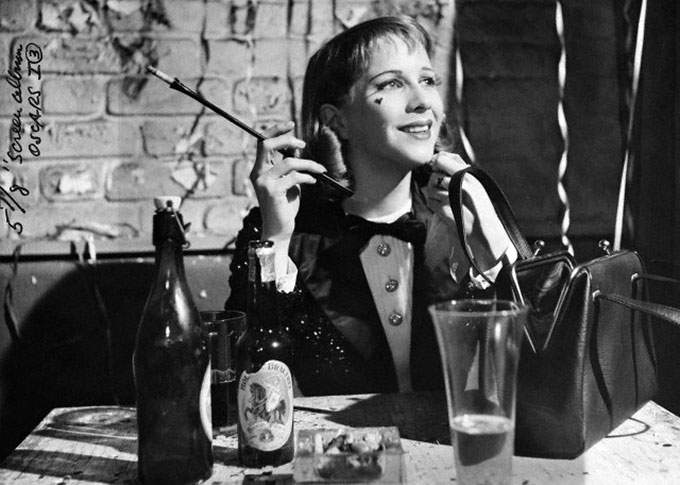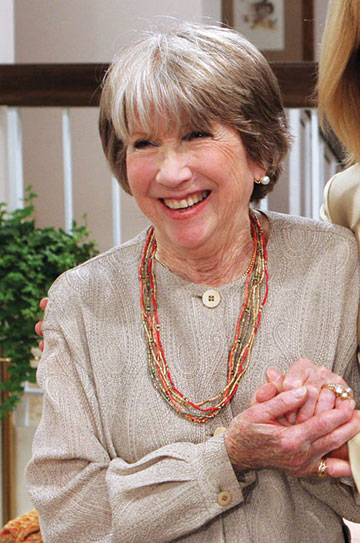The Death of Julie Harris
by Anthony Chase

If the name Sarah Bernhardt means nothing to you, this story might not move you. During her lifetime, Bernhardt (1844-1923) was the greatest actress of her generation, and the most famous woman on the planet. She was as well known for her personal eccentricities as for her thrilling stage performances.
A few years ago, the Jewish Museum in New York City presented an exhibit of artifacts of Bernhardt’s life and career called Sarah Bernhardt: The Art of High Drama. There were posters and costumes, jewelry, furniture she had owned and sculptures she had made, recordings of her voice and silent films of her performances.
The single object that most mesmerized me, however, was very humble: a simple white handkerchief with a delicately tatted edge, embroidered, “Sarah.”
The description explained that the handkerchief had been handed down from Bernhardt to the great Shakespearean actress Julia Marlowe, to Helen Hayes, who gave it to Julie Harris on the opening night of Christopher Isherwood’s I Am a Camera, in which Harris created the role of Sally Bowles in 1951.

Helen Hayes instructed Harris to pass the handkerchief on to another actor when she witnessed a truly great performance. She did so twice; first to Susan Strasberg on the opening night of The Diary of Anne Frank in 1955, and a second time—because Strasberg had died in 1999 without passing the handkerchief on—to Cherry Jones, on the opening night of Imaginary Friends in 1993. Jones, who originated roles in The Baltimore Waltz and Doubt, owns the handkerchief today and loaned it to the exhibit.
I thought of that handkerchief this week when I heard the news that the great Julie Harris had died at the age of 87. Her obituary in the New York Times was appropriately lavish. With her death, one more link to a glorious theatrical past is gone.
I saw remarkable Julie Harris on the stage many times. I met her exactly once. It was December 1995, backstage at the Coconut Grove Playhouse in Florida. She was starring in the 1939 melodrama, Ladies in Retirement, with Eileen Brennan, who also died this month. Charles Nelson Reilly was the director. It was her 10th show with Mr. Reilly, who had also directed her remarkable performance as Emily Dickinson in The Belle of Amherst. (The producers had suggested John Houseman for The Belle of Amherst, but Miss Harris had insisted, “No. I only work with Mr. Reilly.”)
Before I went in for the interview, Mr. Reilly intercepted me. I was writing for Theater Week magazine in New York, and in my 30s at the time. When Reilly saw me, he admitted he was expecting an older journalist and suspiciously grilled me on the details of Harris’s resume. He was concerned that I might not adequately appreciate the stature of this great star.
“You don’t plan to call her Julie, do you?” he asked.
“No, Mr. Reilly,” I said, fully understanding his intent. “I am well aware of whom I am about to meet. Miss Harris is the greatest living American stage actress. That’s why I’m here.”
“Everyone’s coming down to see her,” agreed Reilly with relief.
Miss Harris first made her mark as 12-year-old Frankie in Carson McCullers’s stage adaptation of her novel, Member of the Wedding, when she was 24 years old. The great Harold Clurman directed her, and her memories of that experience give us some of our best insights into his process.
She achieved undisputed stardom when she created the role of Sally Bowles in I Am a Camera—the character is now more familiar from the subsequent musical version, Cabaret. Harris would go on to become such iconic historic people as Joan of Arc, Mary Todd Lincoln, and Emily Dickinson.
Harris rode onto the scene atop the falling crest of the age of great American stage stars. While she was an upcoming ingénue, Katharine Cornell, Lynn Fontanne, and Helen Hayes were at the height of their power and television was new. For a while, it seemed that Harris would cross over. She recreated her stage performances in both Member of the Wedding and I Am a Camera on film, and in 1955, she starred opposite James Dean in East of Eden; she frequently appeared on television, often for the Hallmark Hall of Fame. Instead, Harris would remain a great star of the stage who sometimes appeared on film and television. Yes, she had an Oscar nomination, but she was awarded a record-setting six Tony Awards, including one for her astounding career.
Despite the astonishing breadth and prominence of her stage resume, Harris once observed that when she accepted a role on the nighttime television soap opera Knots Landing, the instant she appeared on the screen, more people saw her than the total of all the people in all the theater audiences for whom she had ever performed throughout her stage career. In the theater, fame evaporates as the final curtain descends.
These thoughts occurred to me as I waited to meet the great actress.
An assistant announced that Miss Harris was ready and we were ushered into her dressing room. The royal build up notwithstanding, the diminutive woman I met was entirely unglamorous and humble. She had removed her makeup and wig. Her hair was short and pulled back. I asked her about the play and how she was preparing.
In the theater, wisdom and tradition are handed down from person to person. There is probably a continuous link from actors working today, straight back to Thespis, by way of Edwin Booth, Sarah Siddons, David Garrick, Richard Burbage, and Roscius, with a detour through a litany of nameless medieval minstrels and mimes.
The actresses who have received the Bernhardt handkerchief are fully aware that its possession signals both their distinctive individual talent and their participation in a great tradition. Some day, Cherry Jones will pass on the handkerchief once owned by Sarah Bernhardt, Helen Hayes, and Julie Harris to another great actress.
I hold my own memories of the theater very dear. In my possession I have a program for the 1995 Coconut Grove production of Ladies in Retirement, inscribed “To Anthony—What a pleasure to speak with you! With affection, Julie Harris.” Someday I will pass it on to someone else who shares my great love of the theater.
|
Issue Navigation> Issue Index > v12n35 (Week of Thursday, August 29) > The Death of Julie Harris This Week's Issue • Artvoice Daily • Artvoice TV • Events Calendar • Classifieds |









 Current Issue
Current Issue